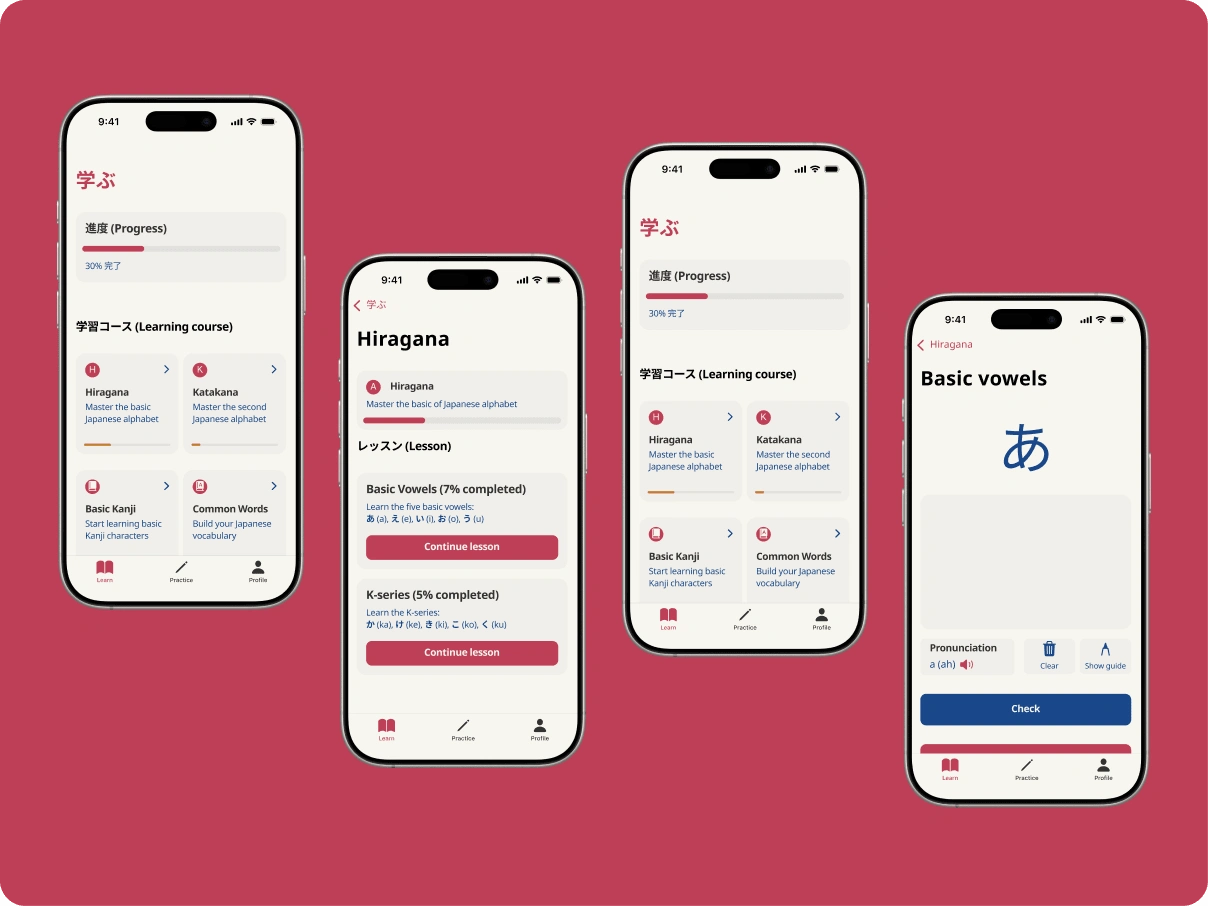Kakimasu

Kakimasu - Japanese learning app
Overview
Kakimasu is a Japanese language learning application with a unique focus on writing skills, designed to make character acquisition intuitive and engaging. The app bridges the gap between traditional textbook-based learning and gamified language apps by providing a structured, writing-centric approach to Japanese.
Timeline
3 months
Role
Product Designer
Tools
Figma, Miro, Swift, Notion
</aside>
Problem Statement
Learning Japanese presents unique challenges due to its three writing systems (hiragana, katakana, and kanji) and the precision required for proper character formation. Existing language apps often prioritize vocabulary and speech, neglecting the critical foundation of writing skills.
User Pain Points
My research identified four critical challenges faced by Japanese language learners:
Disconnected Learning Experience: Most apps teach vocabulary and writing separately, creating a fragmented learning experience
Limited Writing Practice: Few applications offer meaningful stroke-by-stroke guidance with proper feedback
Overwhelming Progression: The path from basic hiragana to complex kanji often feels insurmountable to beginners
Lack of Context: Characters are frequently taught in isolation without meaningful vocabulary context
"I've tried several apps, but they all focus on vocabulary cards. I never feel confident about my writing skills or stroke order." — Hannah Lobban
Research & Discovery
I conducted comprehensive market research and user studies to understand the landscape of Japanese language learning and identify opportunities for innovation.
User Research Methodology
15 participants across beginner, intermediate, and advanced skill levels
45-minute testing sessions with guided tasks and think-aloud protocol
Pre-test questionnaires and post-test interviews
System Usability Scale (SUS) evaluation
Competitive Analysis
I analyzed five leading competitors (Duolingo, Japanese! by Renzo, LingoDeer, Kanji Study, and HelloTalk) to identify market gaps and opportunities:
Key Insights
Writing Gap: Most competitors treated writing as a secondary feature, creating an opportunity for differentiation
Engagement Balance: Users wanted the engagement of gamified apps with the seriousness of academic tools
Progression Clarity: Learners needed a clear path from simple characters to complex kanji
Feedback Importance: Immediate, specific feedback on stroke quality was highly valued
User Personas
Based on my research, I developed two primary personas to guide my design decisions:
Alex, 27
Entertainment Enthusiast
Goals
Learn Japanese to enjoy anime and manga without subtitles
Develop basic writing skills for travel to Japan
Fit learning into a busy schedule with short sessions
Pain Points
Struggles with remembering characters
Finds traditional learning methods boring
Wants cultural context with language learning
Maya, 35
Academic Learner
Goals
Achieve comprehensive Japanese literacy
Master correct writing technique and stroke order
Understand the relationship between characters and meanings
Pain Points
Frustrated by apps that neglect proper writing technique
Wants detailed feedback on character formation
Needs structured progression through all writing systems
Design Process
1. Design Principles
I established core principles to guide my design decisions:
Balance functionality with cultural authenticity
Maintain a clean, uncluttered interface with generous white space
Make complex characters the visual focus
Use animation purposefully for education rather than merely decoration
2. Design System
I developed a comprehensive design system that balanced minimalism with visual interest:
Wireframing and Prototyping
The prototype enabled me to test and refine critical interactions:
Character introduction screens
Stroke practice interface
Progress tracking dashboards
Review and assessment mechanisms
Solution
The final Kakimasu application features five integrated systems I designed to create a comprehensive learning experience:
1. Character Learning System
A progressive system introducing Japanese characters with:
Animated stroke order demonstrations with replay options
Magnified view for complex character details
Practice sessions with on-screen tracing
Handwriting recognition with feedback on accuracy
2. Pronunciation Training
An audio-visual system connecting written characters to spoken language:
Native speaker recordings of all sounds and syllables
Voice recognition for pronunciation feedback
Pitch accent visualization for tonal patterns
Side-by-side comparison of user recordings with native examples
3. Contextual Learning
Characters are never taught in isolation:
Characters shown building into common words
Words demonstrated in practical sentence structures
Cultural context provided for expressions
Grammar points introduced alongside relevant vocabulary
4. Progress Tracking & Gamification
Engagement features to maintain motivation:
Daily challenges
Achievement badges for completed milestones
Daily streak tracking with gentle reminders
Testing & Iteration
My rigorous testing protocol ensured the application met user needs and expectations:
Usability Testing Results
87% of users successfully navigated between main sections without guidance
93% rated stroke order demonstrations as "very helpful"
100% praised the logical progression from Hiragana → Katakana → Kanji
80% found the progress tracking motivating
Key Iterations Based on Feedback
Enhanced Stroke Feedback: Add real-time color indicators for correct/incorrect strokes
Onboarding Tutorial: Implement a guided tour for first-time users
Progress Celebrations: Add more prominent animations and sound effects for achievements
Expanded Examples: Increase the variety of contextual vocabulary and sentences
Impact & Results.
The Kakimasu application achieved strong results in user testing and initial launch metrics:
SUS score of 78/100, placing it in the "Good" usability category
Top-rated aspects: Ease of character viewing (4.6/5) and logical content organization (4.3/5)
87% of testing participants indicated they would continue using the app
93% would recommend the app to others learning Japanese
Market Differentiation
Kakimasu established a unique position in the competitive landscape of Japanese language apps:
Writing-Centric Approach: Placing stroke practice at the core of the learning experience
Integrated Character Progression: Creating a seamless journey from hiragana to kanji
Clean, Focused Interface: Eliminating distractions to maintain focus on character formation
Balanced Learning Methodology: Bridging gamified apps and serious academic tools
Contextual Character Integration: Presenting characters alongside meaningful vocabulary
Next Steps
Based on user feedback and market analysis, I identified several areas for future development:
Spaced Repetition System: Implementing an algorithm to optimize review scheduling
Enhanced Gamification: Adding more game-like elements to increase engagement
Expanded Cultural Content: Developing mini-lessons on Japanese culture and customs
Community Features: Creating opportunities for peer learning and motivation
Educational Partnerships: Exploring relationships with Japanese language schools
Reflection
The development of Kakimasu demonstrated that addressing a specific gap in the market—in this case, the lack of writing-focused Japanese learning tools—can create a compelling user experience. By maintaining a clear focus on writing skills while incorporating contextual learning and engagement features, I created an application that serves a distinct need in the language learning space.
The project reinforced the importance of balancing different user needs—from serious academic learners to casual enthusiasts—while maintaining a consistent, focused design vision. Most importantly, it showed that educational applications can be both rigorous and engaging, challenging the false dichotomy between "serious" learning tools and "fun" gamified apps.
Like this project
1
Posted Mar 20, 2025
Kakimasu is a Japanese language learning application with a unique focus on writing skills, designed to make character acquisition intuitive and engaging.
Likes
1
Views
2
Timeline
Jan 20, 2025 - Mar 20, 2025







